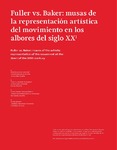Fuller vs. Baker: musas de la representación artística del movimiento en los albores del siglo XX

Use este enlace para citar
http://hdl.handle.net/2183/35937Colecciones
- Investigacion (ETSAC) [511]
Metadatos
Mostrar el registro completo del ítemTítulo
Fuller vs. Baker: musas de la representación artística del movimiento en los albores del siglo XXTítulo(s) alternativo(s)
Fuller vs. Baker: muses of the artistic representation of the movement at the dawn of the 20th centuryFecha
2022-12Cita bibliográfica
Amado Lorenzo, A., Arévalo Rodríguez, F., Escoda Pastor, M.C. y Berkin, G. (2022). Fuller vs. Baker: musas de la representación artística del movimiento en los albores del siglo XX. Revista 180: Arquitectura, arte, diseño, 50, 47-57. https://doi.org/10.32995/rev180.Num-50.(2022).art-1030.
Resumen
[Resumen]
A finales del XIX, la bailarina americana Loïe Fuller se convirtió en una musa de las vanguardias parisinas. Aunque treinta años después, el contexto había cambiado radicalmente, un fenómeno similar se repitió con su compatriota Josephine Baker. Los artistas decó, simbolistas, futuristas y primeros cineastas materializaron las evoluciones de ambas sobre los escenarios. Ellas no solo suscitaron el interés del público de todas las capas sociales, sino el de importantes intelectuales y artistas.
La investigación ha implicado la revisión crítica de estudios específicos sobre ambas: autobiografías, hemerotecas de prensa o trabajos recientes que reivindican la figura innovadora de Fuller, así como la evolución de la danza y su relación con otras artes. Se analiza en paralelo el impacto que estas dos musas contemporáneas provocaron en disciplinas artísticas como la pintura, escultura, ilustración, cine o arquitectura, prestando especial atención a cómo la representación del movimiento se materializó en cada una de ellas.
A partir de esta revisión, se constatan coincidencias, paralelismos y divergencias que ponen de manifiesto que el auténtico vínculo común y atracción real para los artistas no fueron precisamente las dos bailarinas y su propio arte, sino sus revolucionarias, novedosas y sugestivas interpretaciones dinámicas sobre los escenarios: sutiles y elegantes en Fuller, vertiginosas y electrizantes en Baker. El impacto paralelo de ambas en los artistas de sus épocas es el tema vertebrador de la investigación.
Más allá de su conocido rol como artistas de espectáculos y estimuladoras del arte de vanguardia, personificaron algo no valorado entonces en su justa medida, debido a una falta de perspectiva temporal. Representaron, sin saberlo, un punto de inflexión hacia una concepción moderna de las artes que rompía con el clasicismo de modelos artísticos estáticos para evolucionar hacia un interés creciente por fenómenos mucho más dinámicos. [Abstract]
At the end of the 19th century, the American dancer Loïe Fuller became a muse of the Parisian avant-garde. Although thirty years later, her context had changed radically, a similar phenomenon was repeated with her compatriot Josephine Baker. Deco artists, symbolists, futurists and first filmmakers materialized the evolutions of both on stage. They not only aroused the interest of the public from all social classes but also that of important intellectuals and artists. The research has involved the critical review of specific studies on both, autobiographies, newspaper archives or recent studies that claim the innovative figure of Fuller, as well as the evolution of dance and its relationship with other arts. The impact that these two contemporary muses caused in artistic disciplines such as painting, sculpture, illustration, cinema or architecture is analyzed in parallel, paying special attention to how the representation of movement materialized in each of them. From this review, coincidences, parallels and divergences are verified that show that the authentic common bond and real attraction for the artists were not precisely the two dancers and their own art, but the revolutionary, innovative and suggestive dynamic interpretations of the scenarios: subtle and elegant in Fuller, dizzying and electrifying in Baker. The parallel impact of both on the artists of their times is the backbone of the research. Beyond their well-known role as performance artists and promoters of avant-garde art, they personified something that was not valued in its proper measure at the time due to a lack of temporal perspective. Without knowing it, they represented a turning point towards a modern conception of the arts that broke with the classicism of static artistic models to evolve towards a growing interest in much more dynamic phenomena.
Palabras clave
Musas
Art Nouveau
Art déco
Movimiento
Muses
Movement
Art Nouveau
Art déco
Movimiento
Muses
Movement
Versión del editor
ISSN
0718-2309
0718-669X
0718-669X





